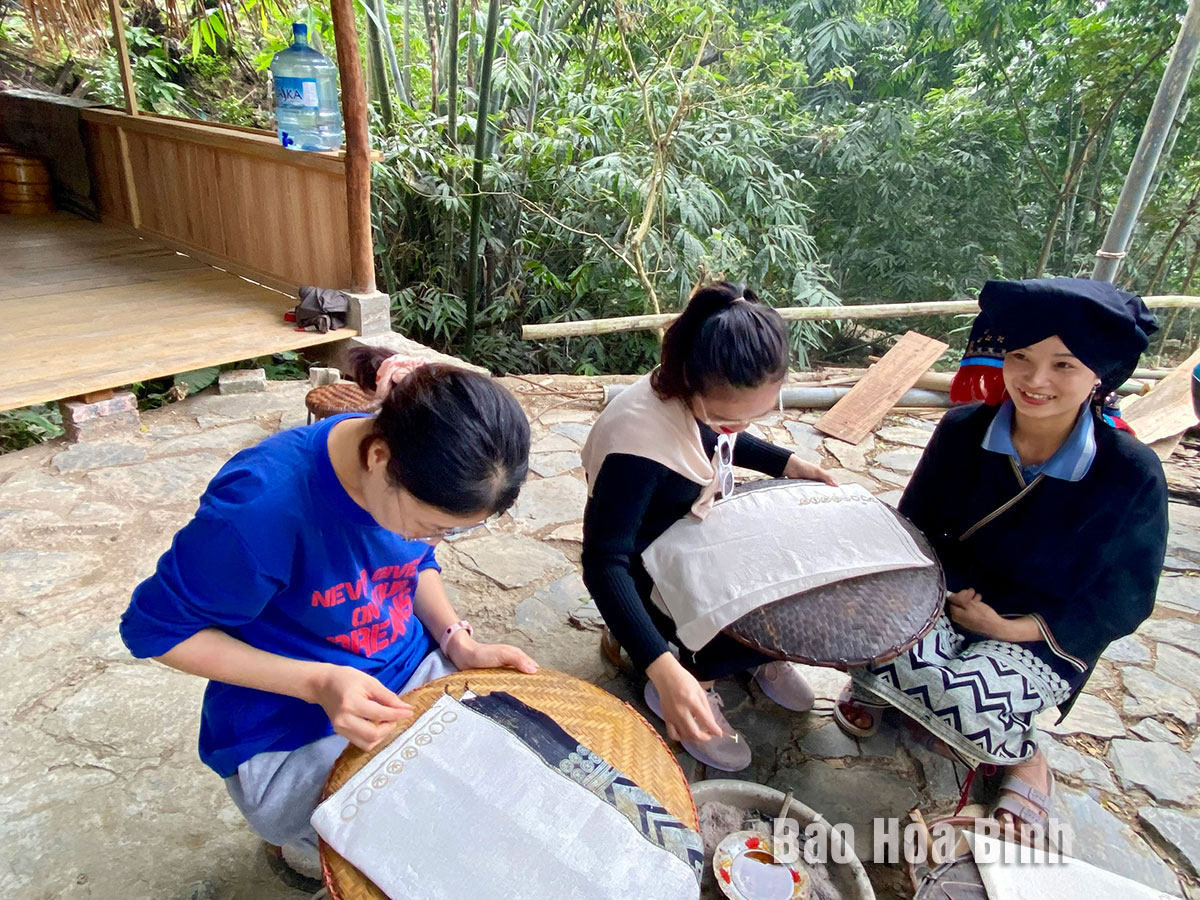
About 100km from Hanoi and located besides Bieu Mountain, the over-500-year Sung village in Cao Son commune, Da Bac district, is home to a Dao Tien ethnic community. With support from the Action on Poverty (AOP) organisation, the Da Bac Community-based Tourism JSC has carried out the community-based tourism model in the village. The village of Dao Tien ethnic people officially opened to tourists in 2017.
Tourists learn and try the craft of beeswax drawing in Sung village of Cao Son commune, Da Bac district.
Community-based tourism activities in Sung village have attracted a large number of travellers, especially foreigners, thanks to the untouched natural beauty and unique culture. Aside from some typical tourism and service products like going sightseeing, exploring Sung Cave, and picking shan tuyet tea buds, community-based tourism here also offers products linked with traditional crafts, thus meeting travellers’ increasingly diverse exploring and experiencing demand.
Ly Van Quy, head of the medicinal material group in Sung village, said that local residents had previously depended on the diverse source of materials in nature to create remedies used in their families. Benefiting from the AOP’s sustainable community-based tourism development project, a traditional medicine group was established in the village and received training as well as financial aid to build workshops, design packages, and develop new products to sustainably tap into local resources and improve local medicinal products’ competitiveness.
The group has launched four products, namely sweet jiaogulan (Gynostemma pentaphyllum) tea, bath herbs, herbal mosquito repellent spray, and red ginger massage solution, he noted.
Meanwhile, the production of "do” paper used to be eroded seriously, and there was only one household involved in this craft. However, the village is home to a large area of materials for making "do” paper, which is why the sustainable community-based tourism development project decided to support Dao Tien ethnic people here to uphold the traditional craft. As a result, a cooperative group for "do” paper production was set up in Sung to develop related products
In addition, the crafts of dyeing fabrics indigo, drawing beeswax on clothes, and making brocades have also been revitalised. The brocade making group now gathers 11 women who were trained in using sewing machines, Japan’s Shibori dyeing technique, and designing to create more diverse and fashionable products to meet tourists’ taste.
Ly Sao Mai, a coordinator at the Da Bac Community-based Tourism JSC in Sung village, said that traditional crafts are being preserved and brought into play to create more diverse and attractive tourism products. At the same time, jobs have been diversified to attract more workers, thus raising income and ensuring stable livelihoods for locals.
She went on to say that more than 80% of the local households are engaging in accommodation, eating, tour guide, and musical performance services, along with brocade, medicinal material, and "do” paper production. The groups of traditional crafts, especially "do” paper and brocade making, now frequently serve visitors coming to explore and experience.
Nguyen Hai Yen, a tourist from Hanoi, said she was very impressed with an ethnic minority village located besides Hoa Binh Lake where the long-standing lifestyle, large forest, and fresh air are still maintained. During the two-day stay in this community-based tourism village, she gained many memorable experiences and learned much more about traditional crafts – one of the unique cultural identities of Dao people. She tried and bought many herbal products such as the massage solution and mosquito repellent as gifts for relatives as she found they are safe, convenient, and useful. A number of such products as handbags, purses, tablecloth, and paintings are also relatively beautiful and have reasonable prices, suitable for tourists to buy as souvenirs.
Phong Phu commune, Tan Lac district of Hoa Binh province, is widely regarded as the cultural heartland of the Muong ethnic group. Among its many traditional communities, Luy Ai hamlet (formerly Ai hamlet) stands out as a rare location where the customs and way of life of the Muong Bi people remain largely intact.
The Truong Kha temple festival, a distinctive cultural event held every three years in Vu Ban township, Lac Son district, returned recently with vibrant rituals and folk traditions of the Muong people. Located next to the Buoi River in the Muong Trao fields, the Truong Kha Temple is dedicated to the three Kun Dol deities, revered for teaching farming techniques, irrigation, weaving, and protecting the harvest.
The demand for spaces serving community activities of residents in various areas across Hoa Binh city has been satisfied as local cultural houses now feature modern, spacious facilities thanks to the effective implementation of Resolution No. 49/NQ-HDND issued on December 28, 2021 by the city People's Council, which approved the plan for reorganising, converting, and allocating land for the construction, repair, and expansion of cultural houses in Hoa Binh’s villages and residential areas until 2025.
At the end of May, the Hoa Binh Provincial Ethnic Arts Troupe organized a series of performances for residents in Region 2 and Region 3 communes across the province. Bringing art to ethnic communities in remote, isolated, and especially disadvantaged areas has become a meaningful activity. These are not merely artistic performances but also journeys to disseminate cultural values, enrich spiritual life, and contribute to preserving the cultural identity of ethnic minorities.
In recent years, alongside the development of a tourism-oriented economy, the traditional brocade weaving craft of the Mong people in Pa Co Commune, Mai Chau district has been gradually preserved and promoted. It has become a unique indigenous cultural feature, contributing to improving the livelihoods of the ethnic minority community.
Hop Tien commune, Kim Boi district, Hoa Binh province is home to nearly 1,260 households with a population of over 5,700 people, 98% of whom are of the Muong ethnic group. Besides economic development, the commune places special emphasis on preserving and promoting the cultural identity of the Muong people.



